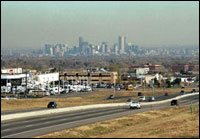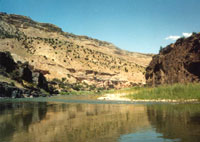This March, the Denver Broncos football team agreed to spend $40 million on a seven-year contract with its new quarterback, Jake Plummer. Since winning two Super Bowls at the end of the 1990s, the Broncos have struggled just to make the playoffs. At his introductory press conference, Plummer predicted, “Winning a Super Bowl is what I believe we are going to do here.”

Denver: the mile dry city.
Photo: NREL.
Meanwhile, the state of Colorado is looking for its silver bullet. After an unprecedented boom in growth and tourism during the 1990s, the state is suffering an unprecedented three-year drought. The average snowpack last year was only a little more than half of normal conditions, and 2002 state stream flows were the lowest in 100 years of record-keeping. Tree-ring data suggest that the state is in the throes of its most severe drought in three centuries.
Colorado is not the only Western state that is suffering. But the high population density in the Denver metropolitan area and along the Rocky Mountain Front Range means Colorado faces a different situation than less populated states such as Montana and Wyoming. Moreover, the distance between the state’s water supply (the majority of which comes from the Western Slope of the Rockies) and the population centers of the Front Range also makes Colorado unique.
Colorado officials and citizens hold the drought responsible for development constraints, rampant summer wildfires, declining tourism, and some share of the state’s $900 million budget deficit. It is no surprise, then, that the state is looking for its own plumber to unclog the stopped flow of water — and cash.
That search has led to a stand-off between state and municipal officials and environmentalists. The former groups say there is no way around building new reservoirs and diversion pipelines. Environmentalists counter that those measures could cost billions of dollars and wreak havoc on Colorado’s rivers and forests; they claim the state’s needs can best be met through reduced water consumption and increased efficiency. The state capitol has become the battlefield for these rival positions, and legislators have considered literally scores of water bills this winter and spring.
Sucking It Up
The Broncos will pay one man $40 million to be quarterback; Colorado is considering an even more extravagant price to get its water back. The state government believes that, even during non-drought conditions, some of the water flowing through the state goes to waste. “The long-term issue is really about storage, because we can’t store all the water we’re entitled to,” says Greg Walcher, director of the Colorado Department of Natural Resources. Walcher says that up to 2 million acre-feet of water that rightfully belong to Colorado (thanks to interstate water agreements) flow out of the state some years. That’s enough to supply 2 million families annually. Much of the lost water leaves through the Colorado River and is used by Arizona and California.

One of Denver’s drought-dry reservoirs.
Photo: Denver Water.
Those who believe that restoring the lost flow is the best way to address droughts and shortages — mainly state officials and developers — are backing the Colorado Aqueduct Return Project, better known as the Big Straw. The proposal entails building a 200-mile long pipeline to pump 400,000 acre-feet of Colorado River water from the Utah border back upstream to the Front Range to be recycled. The river would then carry a constant stream of used water to downstream farms and towns on the Western Slope. The pipeline would have to raise the water 4,500 feet in elevation along its journey, and would cost at least $5 billion. Supporters started their campaign by pushing a $500,000 feasibility study through the state legislature.
To West Slope communities and environmentalists, the project is patently extravagant and absurd. “As we say, the Big Straw sucks,” says Elise Jones, executive director of the Colorado Environmental Coalition. “In this current economy, we could do a lot better with $500,000.”
But Walcher says no project is beyond consideration in these desperate times. “The governor’s telling everybody: ‘We’re not sure it can work but it’s irresponsible not to at least study it,'” says Walcher. The legislature approved the $500,000 for the study, but the project itself could still be derailed due to its outrageous price and substantial environmental impact. At the very least, it would certainly be delayed by legal challenges and other obstacles.
Meanwhile, other bills pose more immediate threats — such as the effort by Front Range water developers to create a $10 billion drought-relief fund that would allow communities to draw revenue bonds from the state in order to construct new water development projects. “Our least favorite bill [this year] is the $10 billion bonding issue,” says Jones. “It’s completely unnecessary and its magnitude is staggering.”
Environmental groups say that despite the budget deficit, lack of financing isn’t blocking large water-development projects. A state bond issue already exists for water projects and cities can purchase existing water rights from farmers for much less money than any new development would cost.
But the lack of thoughtful provisions within the proposed drought-relief fund (such as requiring that all conservation measures be considered before any new development occurs) may encourage towns to build large dams and reservoirs — and could open the door for other environmentally destructive projects, such as clear-cutting state forests to increase water yield and fill new reservoirs. “It’s part of the ‘build-more-storage and log-the-forest agenda,'” says Melinda Kassen, an attorney for Colorado Trout Unlimited and director of the organization’s Colorado Water Project. Kassen and other environmentalists have already defeated a bill that would have included money to study the “logging-for-water” proposal, in part using data from studies showing that clear-cutting public forests would only increase water supply during extremely wet years and would offer no fire protection to communities.

The Gunnison River.
Photo: Colorado BLM.
The drought-relief bond issue could also fund the Little Straw, an approximately 100-mile long pipeline that would pump West Slope water from the Gunnison River basin to the Front Range. The Little Straw’s estimated price of $1 billion to $2 billion looks like a bargain compared to the Big Straw on the Colorado River. “The cynic would say the Big Straw is so big, so expensive, so far-fetched that the Little Straw looks reasonable,” says Kassen.
As far as Kassen and other environmentalists are concerned, spending even a couple billion dollars to capture water is ridiculous, considering the cheaper, more efficient conservation alternatives that they are promoting. Support for the $10 billion drought-relief fund has dissipated toward the close of the legislative session. But even if it fails, voters will probably face a $2 billion water bond referendum on the ballot this November.
Waste Not, Want Not
Colorado’s environmental organizations have their own game plan for addressing the state’s water shortage. A report released by Trout Unlimited and the Colorado Environmental Coalition this past January promotes “Smart Storage” and “Smart Supply” principles, instead of new water development. Smart Storage includes expanding the capacity of existing diversions and reservoirs, stashing surplus water in underground aquifers to limit evaporation, and efficiently returning diverted municipal and agricultural water to streams. Smart Supply alternatives include improving water-conservation practices and enabling flexible, temporary water-sharing agreements between West Slope farms and Front Range cities.
Environmentalists say modest conservation goals can meet Front Range water needs over the next 40 years, even under drought conditions. Replacing half of the green lawns in metro Denver with drought-resistant landscaping and retrofitting half of the inefficient showerheads and toilet bowls in the area would save about 130,000 acre-feet of water each year. Reclamation and treatment of used water would augment the available water supply by nearly 200,000 acre-feet annually.

Drought-tolerant landscaping in Denver.
Photo: Denver Water.
But the legislature has balked at conservation and efficiency measures. Numerous communities across the state mandate that all homes maintain emerald-green lawns seeded with water-hungry Kentucky bluegrass. A bill that would have lifted these local rules to allow drought-resistant landscaping didn’t even make it out of committee. A second piece of legislation aimed at residential water-conservation standards withered under opposition from many municipalities that want to deal with conservation on their own.
The water conservation bill is “worthwhile,” says Walcher, “but it doesn’t really solve the long-term problem” because domestic water consumption, including outdoor applications, makes up less than 6 percent of total water use in the state. Agriculture, meanwhile, accounts for 85 percent of water use.
Bills designed to enable the sharing of that agricultural water with thirsty cities are making their way through the state legislature. Temporary water transfers and leasing of water rights are both popular ideas, because they alleviate water shortages during droughts without forcing farmers and ranchers to close down operations and sell their water outright. One bill that would create an “interruptible supply” of water — where farmers agree to turn over their water rights during drought years in exchange for money and return flows — has received virtually unanimous support.
The legislature is also considering creating water banks, where water can be loaned, traded, or sold. Water banks create a mechanism for realizing the highest value of water rights — allowing cities to buy municipal supplies or environmental groups to purchase in-stream flows for fish and wildlife. Environmentalists say that water leasing and banking can reduce agricultural water use and keep water in streams — without building new reservoirs or straws.
Share and Share Unalike
The city of Aurora, located just east of Denver, understands the complex challenge of meeting diverse water needs. Established in 1891 and originally called Fletcher, the 200-person town was incorporated for less then six months before it had to issue its first bond for water development. Within five years, the town announced restrictions on lawn watering for the first time — but hardly the last. Today, 300,000 people live in Aurora and outdoor water-use restrictions are practically an annual event. Illicit lawn-watering or car-washing can result in fines of up to $500.
Peter Binney, the city utilities director, compares Aurora’s water-supply measures to a portfolio where it has invested in both conservation and development. Aurora encourages conservation through special surcharges on outdoor summer use, and the city’s development relies on water from three different basins in the state.
Binney says facilitating the sharing and distribution of water among existing agricultural users and thirsty, growing cities is the critical goal. “Western water law needs to become a little more nimble,” he says, because it currently devalues the water by making reallocation so difficult. Binney says temporary water transfers and water banks may alleviate the problem, but these projects will still require some construction of infrastructure and pump stations, which he refers to as “mini-straws.” Other Western states have also recognized this shortcoming of water law and created their own water-leasing and water-bank systems. But Colorado appears to be the first state working so hard to institutionalize these ideas through its legislature.
No football team can expect to score by only rushing or only passing during a drive down the field. Colorado might build some new projects to transfer and store water. But the state must balance development with conservation and do so without sinking deeper into deficit, foreclosing on its agricultural economy, dividing the state’s populace, and ruining its wilderness. Striking this balance is also politically smart for state legislators, because polls show that the public opposes new water development that will negatively affect their environment and quality of life.
“The majority of the state is against storage that would detrimentally affect environmental quality,” says Kassen, “People are reasonable. Even though they’re scared, they still don’t want to trash the environment.”


